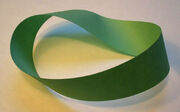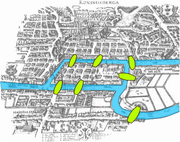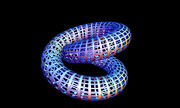No edit summary |
mNo edit summary |
||
| (One intermediate revision by the same user not shown) | |||
| Line 1: | Line 1: | ||
| − | {{StatsPsy} |
+ | {{StatsPsy}} |
| − | {{Main|Topology in psychoanalysis |
+ | {{Main|Topology in psychoanalysis}} |
| − | + | {{Main| Topology in Gestalt analysis}} |
|
Latest revision as of 15:00, 3 September 2006
Assessment |
Biopsychology |
Comparative |
Cognitive |
Developmental |
Language |
Individual differences |
Personality |
Philosophy |
Social |
Methods |
Statistics |
Clinical |
Educational |
Industrial |
Professional items |
World psychology |
Statistics: Scientific method · Research methods · Experimental design · Undergraduate statistics courses · Statistical tests · Game theory · Decision theory
- Main article: Topology in psychoanalysis
- Main article: Topology in Gestalt analysis

A Möbius strip, a surface with only one side and one edge; such shapes are an object of study in topology.
Topology (Greek topos, place and logos, study) is a branch of mathematics concerned with spatial properties preserved under bicontinuous deformation (stretching without tearing or gluing); these are the topological invariants. When the discipline was first properly founded, in the early years of the 20th century, it was still called geometria situs (Latin geometry of place) and analysis situs (Latin analysis of place). From around 1925 to 1975 it was the most important growth area within mathematics.
Topology also refers to a particular mathematical object studied in this area. In this sense, a topology is a family of open sets which contains the empty set and the entire space. If a family of sets is in the topology, then its union must be in the topology. If a finite family of sets is in the topology, then its intersection must be in the topology. A set equipped with a topology is called a topological space. The remainder of this article deals with the branch of mathematics known as topology.
Topology has sometimes been called rubber-sheet geometry, because it does not distinguish between a circle and a square (a circle made out of a rubber band can be stretched into a square) but does distinguish between a circle and a figure eight (you cannot stretch a figure eight into a circle without tearing). The spaces studied in topology are called topological spaces. They vary from familiar manifolds to some very exotic constructions.
Topology has introduced a new geometric language (simplicial complexes, homotopy, cohomology, Poincaré duality, fibrations, vector bundles, sheaves, characteristic classes, Morse functions, homological algebra, spectral sequences). It has had a major impact on the fields of differential geometry, algebraic geometry, dynamical systems and partial differential equations in the large, and several complex variables. Geometry in the sense of Michael Atiyah and his school now includes all of this. Internally to the subject, point-set topology or general topology is the study of topological spaces without further restrictions; other areas deal with topological spaces that look more like manifolds. These include algebraic topology (which grew out of combinatorial topology), geometric topology, low-dimensional topology dealing for example with knot theory, and differential topology. This article is a general overview of topology. For more precise mathematical definitions, see topological spaces or one of the more specialized articles listed below. The topology glossary contains definitions of terms used throughout topology.
History

The Seven Bridges of Königsberg is a famous problem in topology.
The root of topology was in the study of geometry in ancient cultures. Leibniz was the first to employ the term analysus situs, later employed in the 19th century to refer to what is now known as topology. Leonhard Euler's 1736 paper on Seven Bridges of Königsberg is regarded as one of the first topological results.
Georg Cantor, the inventor of set theory, had begun to study the theory of point sets in Euclidean space, in the later part of the 19th century, as part of his study of Fourier series.
Henri Poincaré published Analysis Situs in 1895, introducing the concepts of homotopy and homology.
Maurice Fréchet, unifying the work on function spaces of Cantor, Volterra, Arzelà, Hadamard, Ascoli and others, introduced the concept of metric space in 1906.
In 1914, Felix Hausdorff, generalizing the notion of metric space, coined the term "topological space" and gave the definition for what is now called Hausdorff space.
Finally, a further slight generalization in 1922, by Kazimierz Kuratowski, gives the present-day concept of topological space.
The term "topologie" was introduced in German in 1847 by Johann Benedict Listing in Vorstudien zur Topologie, Vandenhoeck und Ruprecht, Göttingen, pp. 67, 1848. However, Listing had already used the word for ten years in correspondence. "Topology", its English form, was introduced in 1883 in the journal Nature to distinguish "qualitative geometry from the ordinary geometry in which quantitative relations chiefly are treated". The separate status of the topologist, a specialist in topology, was used in 1905 in the magazine Spectator.
Elementary introduction

A toroid in three dimensions; A coffee cup and a donut are both topologically indistinguishable from this toroid.
Topological spaces show up naturally in mathematical analysis, abstract algebra and geometry. This has made topology one of the great unifying ideas of mathematics. General topology, or point-set topology, defines and studies some useful properties of spaces and maps, such as connectedness, compactness and continuity. Algebraic topology is a powerful tool to study topological spaces, and the maps between them. It associates "discrete", more computable invariants to maps and spaces, often in a functorial way. Ideas from algebraic topology have had strong influence on algebra and algebraic geometry.
The motivating insight behind topology is that some geometric problems depend not on the exact shape of the objects involved, but rather on the "way they are connected together". One of the first papers in topology was the demonstration, by Leonhard Euler, that it was impossible to find a route through the town of Königsberg (now Kaliningrad) that would cross each of its seven bridges exactly once. This result did not depend on the lengths of the bridges, nor on their distance from one another, but only on connectivity properties: which bridges are connected to which islands or riverbanks. This problem, the Seven Bridges of Königsberg, is now a famous problem in introductory mathematics, and led to the branch of mathematics known as graph theory.
Similarly, the hairy ball theorem of algebraic topology says that "one cannot comb the hair on a ball smooth". This fact is immediately convincing to most people, even though they might not recognize the more formal statement of the theorem, that there is no nonvanishing continuous tangent vector field on the sphere. As with the Bridges of Königsberg, the result does not depend on the exact shape of the sphere; it applies to pear shapes and in fact any kind of blob (subject to certain conditions on the smoothness of the surface), as long as it has no holes.
In order to deal with these problems that do not rely on the exact shape of the objects, one must be clear about just what properties these problems do rely on. From this need arises the notion of topological equivalence. The impossibility of crossing each bridge just once applies to any arrangement of bridges topologically equivalent to those in Königsberg, and the hairy ball theorem applies to any space topologically equivalent to a sphere. Formally, two spaces are topologically equivalent if there is a homeomorphism between them. In that case the spaces are said to be homeomorphic, and they are considered to be essentially the same for the purposes of topology.
Formally, a homeomorphism is defined as a continuous bijection with a continuous inverse, which is not terribly intuitive even to one who knows what the words in the definition mean. A more informal criterion gives a better visual sense: two spaces are topologically equivalent if one can be deformed into the other without cutting it apart or gluing pieces of it together. The traditional joke is that the topologist can't tell the coffee cup she is drinking out of from the doughnut she is eating, since a sufficiently pliable donut could be reshaped to the form of a coffee cup by creating a dimple and progressively enlarging it, while shrinking the hole into a handle.
One simple introductory exercise is to classify the lowercase letters of the English alphabet according to topological equivalence. To be simple, it is assumed that the lines of the letters have nonzero width. Then in most fonts in modern use, there is a class {a,b,d,e,o,p,q} of letters with one hole, a class {c,f,h,k,l,m,n,r,s,t,u,v,w,x,y,z} of letters without a hole, and a class {i,j} of letters consisting of two pieces. g may either belong in the class with one hole, or be the sole element of a class of letters with two holes, depending on whether or not the tail is closed. For a more complicated exercise, it may be assumed that the lines have zero width; one can get several different classifications depending on which font is used. Letter topology is of practical relevance in stencil typography: The font Braggadocio, for instance, can be cut out of a plane without falling apart.
Some theorems in general topology
- Every closed interval in R of finite length is compact. More is true: In Rn, a set is compact if and only if it is closed and bounded. (See Heine-Borel theorem).
- Every continuous image of a compact space is compact.
- Tychonoff's theorem: The (arbitrary) product of compact spaces is compact.
- A compact subspace of a Hausdorff space is closed.
- Every sequence of points in a compact metric space has a convergent subsequence.
- Every interval in R is connected.
- The continuous image of a connected space is connected.
- A metric space is Hausdorff, also normal and paracompact.
- The metrization theorems provide necessary and sufficient conditions for a topology to come from a metric.
- The Tietze extension theorem: In a normal space, every continuous real-valued function defined on a closed subspace can be extended to a continuous map defined on the whole space.
- The Baire category theorem: If X is a complete metric space or a locally compact Hausdorff space, then the interior of every union of countably many nowhere dense sets is empty.
- On a paracompact Hausdorff space every open cover admits a partition of unity subordinate to the cover.
- Every path-connected, locally path-connected and semi-locally simply connected space has a universal cover.
- Topological spaces have a topological dimension.
Some useful notions from algebraic topology
See also list of algebraic topology topics.
- Homology and cohomology: Betti numbers, Euler characteristic.
- Intuitively-attractive applications: Brouwer fixed-point theorem, Borsuk-Ulam theorem, Ham sandwich theorem.
- Homotopy groups (including the fundamental group).
- Chern classes, Stiefel-Whitney classes, Pontryagin classes.
Outline of the deeper theory
- (Co)fibre sequences: Puppe sequence, computations
- Homotopy groups of spheres
- Obstruction theory
- K-theory: KO-theory, algebraic K-theory
- Stable homotopy theory
- Brown's representability theorem
- (Co)bordism
- Signatures
- Brown-Peterson BP and Morava K-theory
- Surgery obstructions
- H-spaces, infinite loop spaces, A∞ rings
- Homotopy theory of affine schemes
- Intersection cohomology
Generalizations
Occasionally, one needs to use the tools of topology but a "set of points" is not available. In pointless topology one considers instead the lattice of open sets as the basic notion of the theory, while Grothendieck topologies are certain structures defined on arbitrary categories which allow the definition of sheaves on those categories, and with that the definition of quite general cohomology theories.
References
- James Munkres (1999). Topology, 2nd edition, Prentice Hall. ISBN 0-13-181629-2.
- John L. Kelley (1975). General Topology, Springer-Verlag. ISBN 0-387-90125-6.
- Clifford A. Pickover (2006). The Möbius Strip: Dr. August Möbius's Marvelous Band in Mathematics, Games, Literature, Art, Technology, and Cosmology, Thunder's Mouth Press (Provides a popular introduction to topology and geometry). ISBN 1-56025-826-8.
- Oxford English Dictionary
- Boto von Querenburg: Mengentheoretische Topologie. Heidelberg, Springer-Lehrbuch, ISBN 3-540-67790-9
See also
- Covering map
- Differential topology
- Geometric topology
- Digital topology
- Important publications in topology
- Link topology
- List of general topology topics
- List of geometric topology topics
- Mereotopology
- Network topology
- Topology glossary
- Topological space
- Topology of the universe
- Counterexamples in Topology
External links
- Elementary Topology: A First Course Viro, Ivanov, Netsvetaev, Kharlamov (St. Petersburg University)
- An invitation to Topology Planar Machines' web site
- Geometry and Topology Index, MacTutor History of Mathematics archive
- ODP category
- The Topological Zoo at The Geometry Center
- Topology Atlas
- Topology Course Lecture Notes Aisling McCluskey and Brian McMaster, Topology Atlas
- Topology Glossary
Major fields of mathematics |
|---|
|
Logic · Set theory · Algebra (Elementary – Linear – Abstract) · Discrete mathematics · Number theory · Analysis · Geometry · Topology · Applied mathematics · Probability · Statistics · Mathematical physics |
ar:طوبولوجيا cs:Topologie da:Topologi de:Topologie (Mathematik) el:Τοπολογία es:Topología eo:Topologio fa:توپولوژی fr:Topologie ko:위상수학 io:Topologio is:Grannfræði he:טופולוגיה lt:Topologija nl:Topologie ka:ტოპოლოგია no:Topologi pt:Topologia (matemática) ru:Топология simple:Topology sl:Topologija fi:Topologia (matematiikka) sv:Topologi th:ทอพอลอยี vi:Tô pô uk:Топологія zh:拓扑学
| This page uses Creative Commons Licensed content from Wikipedia (view authors). |

